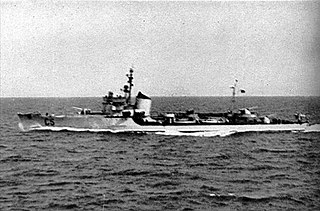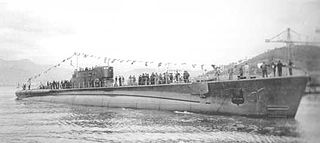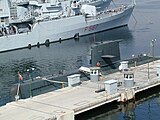
Giuliano Amato is an Italian politician who twice served as Prime Minister of Italy, first from 1992 to 1993 and again from 2000 to 2001. Upon Arnaldo Forlani's death in July 2023, Amato became the country's earliest-serving surviving Prime Minister.

The Italian Navy is one of the four branches of Italian Armed Forces and was formed in 1946 from what remained of the Regia Marina after World War II. As of August 2014, the Italian Navy had a strength of 30,923 active personnel, with approximately 184 vessels in service, including minor auxiliary vessels. It is considered a multiregional and a blue-water navy.

The Regia Marina (RM) or Royal Italian Navy was the navy of the Kingdom of Italy from 1861 to 1946. In 1946, with the birth of the Italian Republic, the Regia Marina changed its name to Marina Militare.

Rodrigo is an opera in three acts composed by George Frideric Handel. Its original title was Vincer se stesso è la maggior vittoria. The opera is based on the historical figure of Rodrigo, the last Visigothic king of Spain. The libretto was based on Francesco Silvani's II duello d'Amore e di Vendetta. Dating from 1707, it was Handel's first opera written for performance in Italy, and the first performance took place in Florence late in 1707.

The Spica-class was a class of torpedo boats of the Regia Marina during World War II. These ships were built as a result of a clause in the Washington Naval Treaty, which stated that ships with a tonnage of less than 600 could be built in unlimited numbers. Thirty-two ships were built between 1934 and 1937, thirty of which entered service with Italy.

The Nazario Sauro class are diesel-electric submarines operated by the Italian Navy. All boats were built by Fincantieri in Monfalcone.
SM U-42 was a submarine ordered for construction by the Imperial German Navy. The vessel was designed by the naval engineer Cesare Laurenti, and laid down on 18 August 1913 in Italy at Società FIAT-San Giorgio, Muggiano, La Spezia. It served as the basis for the design of the Pacinotti-class submarines. The vessel was confiscated by the Italian government after entering the World War I. The vessel was renamed Balilla and served with the Royal Italian Navy until sunk in a battle on 14 July 1916 with two torpedo boats.
Italian submarine Luigi Torelli was a Marconi-class submarine of the Italian navy during World War II. The vessel operated in the Atlantic from September 1940 until mid-1943, then was sent to the Far East. After Italy's surrender in 1943, the Luigi Torelli was taken over by Nazi Germany's Kriegsmarine, then, in the waning months of the war, the Japanese Imperial Navy. It was one of only two ships to serve in all three major Axis navies, the other being the Italian submarine Comandante Cappellini.

Eva Grimaldi is an Italian actress and model.

The Calvi class was a class of three submarines built by Oderno-Terni-Orlando in Genoa for the Royal Italian Navy. The submarines were built in 1935, and all three served in the Mediterranean at the start of the Second World War. The boats were transferred to the BETASOM Atlantic submarine base at Bordeaux in August 1940. In December 1941 the boats were used for a rescue mission of 254 sailors from the sunken German auxiliary cruiser Atlantis. After Calvi had been sunk, Finzi and Tazzoli were selected for conversion to "transport submarines" in order to exchange rare or irreplaceable trade goods with Japan. Cargo capacity of 160 tons reduced reserve buoyancy from 20–25% to 3.5–6%; and armament was reduced to defensive machine guns.
Pietro Micca was an Italian submarine which served with the Regia Marina in World War II. She was the third ship named after Pietro Micca, the Savoyard soldier who became a national hero for his sacrifice in the defence of Turin against the French troops in 1706. This boat was the prototype for a class of fast, long range submarines with conventional torpedo armament, naval mine laying capability, and useful secret transport capacity. The ship was built at the Tosi shipyard in Taranto. She was laid down on 15 October 1931 and launched on 31 March 1935. The boat fully met design requirements, but was too expensive to be repeated.
Giuseppe Finzi was one of three Calvi-class submarines built for the Regia Marina during the 1930s. Completed in 1936, she played a minor role in the Spanish Civil War of 1936–1939 supporting the Spanish Nationalists. The submarine made multiple patrols in the Atlantic Ocean during the Second World War, sinking five Allied ships. Gisueppe Finzi began conversion into a transport submarine in 1943, but was captured by the Germans in September 1943 before it was completed and redesignated as UIT-21. She was scuttled by them in August 1944 to prevent her capture.
Rear Admiral Roberto Camerini is an Italian Navy officer, currently serving as Commander Maritime Command North.

Enrico Tazzoli was one of three Calvi-class submarines built for the Regia Marina during the 1930s. Completed in 1936, she played a minor role in the Spanish Civil War of 1936–1939 supporting the Spanish Nationalists. She operated in the Atlantic during the Second World War and was second only to the submarine Leonardo da Vinci as the highest scoring Italian submarine of the conflict. Enrico Tazzoli was converted in 1943 to be a submarine transport for blockade-running between Europe and the Far East. She was lost on her first voyage in this role.

Leonardo da Vinci was a Sauro-class submarine of the Italian Navy.

Primo Longobardo is a Sauro-class submarine of the Italian Navy.

Gianfranco Gazzana Priaroggia is a Sauro-class submarine of the Italian Navy.

The Italian torpedo boat Sagittario was a Spica-class torpedo boat built for the Regia Marina in 1936. During the Battle of the Mediterranean, in the Second World War, Sagittario was involved in several convoy missions, the most notable that known as the "Sagittario convoy", in the course of the Battle of Crete, for which her commander, Giuseppe Cigala Fulgosi, was awarded the Gold Medal of Military Valour. Sagittario survived the war. Re-classified as corvette in 1949, she was scrapped in 1964.
This page is based on this
Wikipedia article Text is available under the
CC BY-SA 4.0 license; additional terms may apply.
Images, videos and audio are available under their respective licenses.















